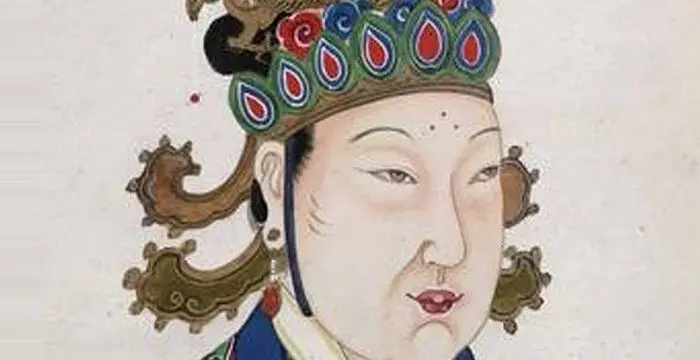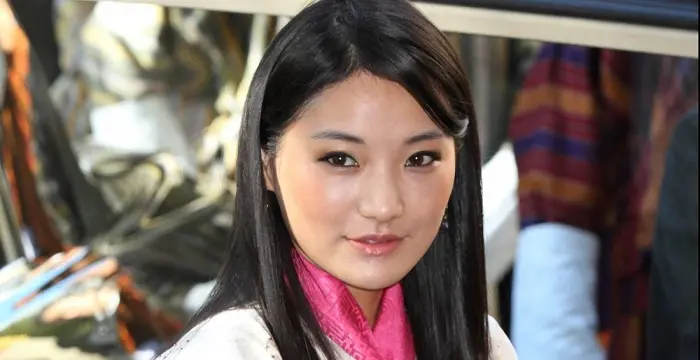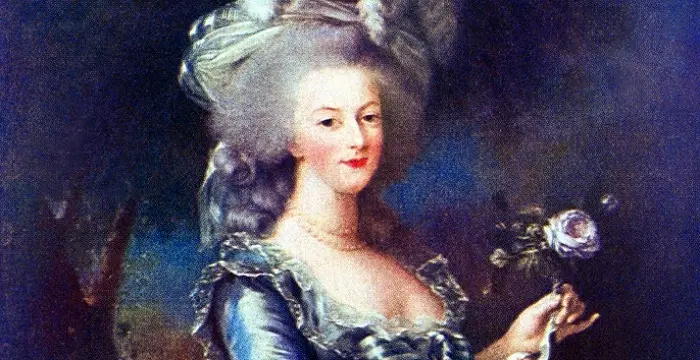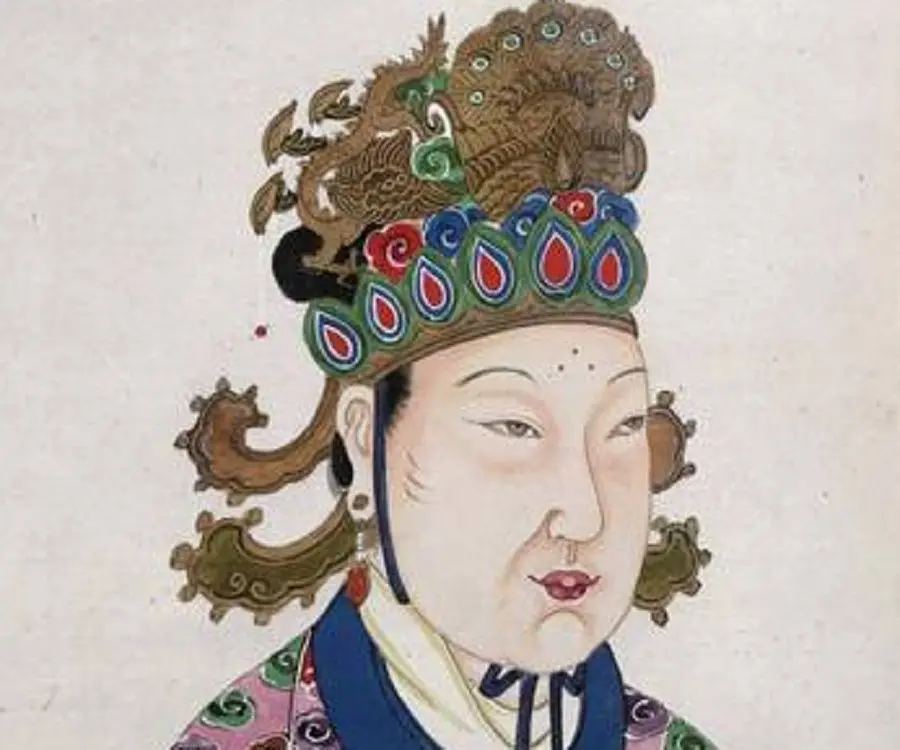
Wu Zetian - Empresses, Career and Personal Life
Wu Zetian's Personal Details
Wu Zetian was an empress of China during the Tang dynasty
| Information | Detail |
|---|---|
| Birthday | February 17, 625 |
| Died on | December 16, 705 |
| Nationality | Chinese |
| Famous | Historical Personalities, Empresses & Queens, Empress, Empresses, Queens |
| Spouses | Emperor Gaozong of Tang (m. 652 AD–683 AD), Emperor Taizong of Tang (m. 637 AD–649 AD) |
| Known as | Wu Zhao, Wu Hou |
| Birth Place | Chang'an |
| Gender | Female |
| Sun Sign | Aquarius |
| Born in | Chang'an |
| Famous as | Chinese Empress |
| Died at Age | 80 |
// Famous Queens
Jetsun Pema
Jetsun Pema is the Queen consort of Bhutan. Check out this biography to know about her childhood, family life, achievements and fun facts about her life.
Princess Alice of Battenberg
Princess Andrew of Greece and Denmark, also known as Princess Victoria Alice Elizabeth Julia Marie of Battenberg, was the mother of Prince Philip, Duke of Edinburgh and mother-in-law of Queen Elizabeth II. This biography profiles her childhood, famil
Marie Antoinette
Marie Antoinette was the Queen of France and Navarre from 1774 to 1792. who played a major role in provoking the French Revolution. This biography of Marie Antoinette provides detailed information about her childhood and life
Wu Zetian's photo
Who is Wu Zetian?
Wu Zetian was a Chinese historical figure, who, in different stages of her life, was a concubine, empress consort, empress dowager and empress regent. She was the only woman in the history of China to have called herself “Huangdi”, a title that only the emperors of China had used since the time of Qin Shi Huang. Alternatively known as Wu Zhao, Wu Hou, and Tian Hou, she is also referred to in English as Empress Consort Wu or by the deprecated term "Empress Wu." She established the short-lived Zhou Dynasty during her regency. Wu Zetian was raised in an affluent family and was able to dedicate herself entirely to education. At the age of 14, she became an imperial concubine of Emperor Taizong of Tang and after his death became the concubine and eventually the wife of his son, Emperor Gaozong of Tang. She had always wielded considerable power in the palace and in the Tang administration. Following her husband’s debilitating stroke in 660, she assumed the role of an administrator of the court, effectively becoming the sovereign of the empire. After the death of her husband, Wu Zetian continued to hold the position until 705 and was regarded as a competent ruler. While she has been criticised for brutality in her ascendency to power and for the tyrannical hold on it afterwards, she was kind to her people, ushering in several economic, social, cultural and political changes. Wu Zetian passed away in 705 and subsequently, the Tang dynasty was restored by her son and successor, Emperor Zhongzong of Tang.
Childhood & Early Life
Wu Zetian’s clan, the Wu Tang, hailed from the ancient Wenshui County, Bingzhou, which is now known as the city of Taiyuan, located in the Shanxi province. Her exact place of birth is a matter of historical debate. Some scholars argue that she was born in the imperial city of Chang'an, while others insist that she came from Lizhou, (modern-day Guangyuan in Sichuan). Her birth date was February 17, 624.
The year 624 was the seventh year of the reign of Emperor Gaozu of Tang. The year also witnessed a total solar eclipse which was visible across China. Her father, Wu Shihuo, was a rich timber merchant and her mother, the Lady Yang, hailed from the powerful Yang family. Wu Zetian had at least four siblings, two brothers, Wu Yuanqing and Wu Yuanshuang, and two sisters, Wu Shun, Lady of Han and Lady Wu, Lady of Guo.
Her family had significant influence in the royal court. During his youth, Emperor Gaozu of Tang spent time in the Wu household. After his ascension, he did not forget Wu Zetian’s family and bestowed upon them money, grain, clothes, and land. Wu Shihuo even went on to hold several ministerial posts, including the governorships of Yangzhou, Lizhou, and Jingzhou.
Like any other girl from an affluent family in ancient China, Wu Zetian did not have to worry about or learn household chores. Instead, encouraged by her father and an incredibly progressive society by contemporary standards, she could devote her time entirely to education. She was taught politics and other matters of governance, mathematics, writing, literature, and music. Ancient records reveal that she had big eyes, long neck, a big face, and square forehead and was considered beautiful according to the norms of her time.
Concubine of Emperor Taizong of Tang
When Wu Zetian turned 14, she was sent to the imperial court as the concubine of Emperor Taizong of Tang. On the day of her departure, her mother was inconsolable at the prospect of losing her daughter. However, Wu Zetian apparently told her the following, “How do you know that it is not my fortune to meet the Son of Heaven?" Realising the enormity of her daughter’s ambition, Lady Yang ceased crying.
Initially, she served as an ancient equivalent of secretary. She got the opportunity to continue her education. Her title, in those days, was cairen, which made her one of the consorts of the fifth rank in Tang's nine-rank system for imperial officials, nobles, and consorts.
During her early years in the palace, she did not receive much favour from Emperor Taizong but they did have sexual encounters. Sometime during the last few years of Emperor Taizong’s reign, she began an affair with his youngest son, Li Zhi, who later succeeded him as Emperor Gaozong of Tang.
Emperor Taizong died in 649 without having any children with her. According to the tradition that consigned any consort of a deceased emperor to a monastery if she had failed to provide him with a child, she was sent to Ganye Temple to live out her life as a Buddhist nun.
Li Zhi later visited her in the monastery and found her to be more beautiful, intelligent, and intriguing than ever. He brought her back with him and added her to his own harem.
Empress Consort of Emperor Gaozong of Tang
By the early 650s, Wu Zetian had established herself in the Tang court as a Zhaoyi, the highest ranking of the nine concubines of the second rank. Her power and influence rapidly grew in a short period of time.
Emperor Gaozong’s wife then was Empress Wang and his favourite concubine was Consort Xiao. Empress Wang was well-aware of the extent of the relationship between the emperor and Consort Wu and sought to use her in her schemes against Consort Xiao, whom she considered her greatest adversary.
Empress Wang was successful in her endeavour, but failed to recognize Consort Wu for what she truly was. Consort Wu soon became the emperor’s most beloved concubine and in 652, their first child together, a son named Li Hong was born. A year later, she gave birth to their second son, Li Xián. By 654, both Empress Wang and Consort Xiao were not in favour with the emperor and attempted to defeat Consort Wu by forming an alliance together, but it was not successful.
In 654, Consort Wu’s daughter, Princess Si of Anding died soon after her birth. Consort Wu accused Empress Wang of strangulating her daughter. According to the testimony by several supposed eyewitnesses, Empress Wang was seen near the child’s room. Consort Wu convinced the emperor that Empress Wang, who did not have an alibi nor could provide a defence, had done so out of jealousy. The emperor sought to remove her from her position but could not because of a reluctant bureaucracy. Traditional historians generally believed that it was Consort Wu who had killed her own daughter.
In 655, however, Consort Wu got rid of both Empress Wang and Consort Xiao after accusing them of witchcraft. They were cruelly executed and Wu Zetian became the new Empress Consort of the Tang Empire. Within a year, her son, Li Hong replaced Consort Liu's son Li Zhong as the heir apparent. She was thorough and ruthless in her reprisals against the officials, nobles, and concubines who opposed her. She exiled a few and executed the rest. By 660, her authority and influence rivalled that of Emperor Gaozong.
Empress Wu earned the emperor’s ire in 664 because he thought she was interfering in the imperial governance a bit too much. In the late 660s, the emperor began to suffer from an illness that caused painful headaches and loss of vision and allowed Empress Wu to make rules in his stead. He was agitated by the power that she had gained. Furthermore, she had employed Taoist sorcerer Guo Xingzhen in her pursuit of witchcraft. It was reported back to the emperor who sought to depose her.
When she heard of his plan, she immediately went to him to plead her case. She was successful and subsequently sought vengeance against them who she thought had wronged her. They all suffered consequences, including former heir apparent, Li Zhong, who was ordered by his father to commit suicide.
By 675, Emperor Gaozong’s health had severely deteriorated and he entertained the idea of making Wu Zetian the regent but was dissuaded from doing so by his advisors. There were several individuals towards whom Empress Wu became angry during this period, including her two sons. According to traditional historians, she poisoned and killed her firstborn, the Crown Prince Li Hong, after he displeased her several times. After her second son, Li Xián was made the crown prince, he too eventually earned his mother’s wrath and was subsequently deposed and exiled.
It was her third son, Li Xian (same sounding but contains different Chinese characters) who became the new heir apparent, adopting the new name, Li Zhe. Emperor Gaozong passed away in 683. Li Zhe succeeded him as Emperor Zhongzong, but the true power remained with the empress dowager and regent.
Empress Dowager & Empress Regent
Immediately after his ascension, Emperor Zhongzong showed signs of rebellion against his mother. Moreover, he was completely controlled by his wife, Empress Wei, and her family. Empress Dowager Wu acted swiftly, deposing Emperor Zhongzong and replacing him with her youngest son, Li Dan, the Prince of Yu, who ascended the throne as Emperor Ruizong. She later forced her second son, Li Xián, to commit suicide.
According to many historians, China once used to be a matriarchal society before Confucius and Mencius redefined the social construction and allocated women to a subservient role. Wu Zetian, as a woman in the position of absolute power, not only disagreed with the notion but also contradicted it. She embraced Buddhism over both Confucianism and Taoism, making it the state religion. At the height of her power, she proclaimed herself to be a female incarnation of the Buddha Maitreya to assert her sovereignty.
Sometime in the mid-680s, she began an affair with a Buddhist monk named Huaiyi who would receive various honours in the next few years. However, he was later replaced with another lover, the imperial physician Shen Nanqiu. She also reportedly kept a host of male concubines.
In 686, she officially established a secret police service to deal with her political adversaries. They were brutal and efficient and carved out a fearsome reputation about themselves. The organization helped her in deposing, exiling and even executing many high ranking bureaucrats. There are records that claim that, through her secret police, she killed thousands of commoners and nobles alike.
In 690, she compelled Emperor Ruizong to abdicate the Dragon Throne in favour of her and set up the Zhou dynasty, claiming that she had descended from the ancient dynasty of the same name that had lasted longer than any other ruling dynasty in Chinese history. She also adopted the title ‘Huangdi’, which had been used by Chinese emperors since Qin Shi Huang (259–210 BC) and was the first and the only female Chinese sovereign to do so.
One of most unique attributes of her reign was the reformation she brought about in the state administration. She mandated that everyone who was aspiring to be a government official must pass a series of examinations first. This ensured that the empire would be administered by educated and competent people and not by nepotistic dynasties. She also lowered the taxes for the farmers, which in turn, increased agricultural productivity.
On the military and diplomatic front, Wu Zetian shrunk the army and hosted diplomats from other empires. She expanded her empire to Central Asia while her campaigns in Tibet and in the northeast proved to be less successful. In Korea, the Chinese had moderate success. After defeating the Goguryeo Kingdom with the help of the Silla, they attacked their allies. In retaliation, Silla, Goguryeo, and other Korean forces joined together to push the foreigners out of the peninsula.
Death & Legacy
By 705, Wu Zetian, who was over 80 years old by then, had suffered several bouts of serious illnesses. She was unable to hold court and was ruling by proxy. There was a well-organised coup in February that year, ending with the executions of her trusted officers. An edict was issued in her name on 22 February passing the Dragon Throne to Li Xián, who retook his imperial name, Emperor Zhongzong of Tang. On 3 March, Zhou dynasty was formally abolished and the Tang Dynasty was restored.
She was moved to the Shangyang Palace where she died on 16 December. At the time of her death, she held the title of Empress Regnant Zetian Dasheng. Wu Zetian was buried alongside her husband at the Qianling Mausoleum.
Wu Zeitan was a poetess herself and made her court a focus of literary creativity. The administrative changes she brought about were emulated in the years to come in Chinese history. While traditional history had judged her negatively, even it could not deny that she was an intelligent and able leader.
// Famous Empresses
Jetsun Pema
Jetsun Pema is the Queen consort of Bhutan. Check out this biography to know about her childhood, family life, achievements and fun facts about her life.
Princess Alice of Battenberg
Princess Andrew of Greece and Denmark, also known as Princess Victoria Alice Elizabeth Julia Marie of Battenberg, was the mother of Prince Philip, Duke of Edinburgh and mother-in-law of Queen Elizabeth II. This biography profiles her childhood, famil
Marie Antoinette
Marie Antoinette was the Queen of France and Navarre from 1774 to 1792. who played a major role in provoking the French Revolution. This biography of Marie Antoinette provides detailed information about her childhood and life
Wu Zetian biography timelines
- // 624The year 624 was the seventh year of the reign of Emperor Gaozu of Tang. The year also witnessed a total solar eclipse which was visible across China. Her father, Wu Shihuo, was a rich timber merchant and her mother, the Lady Yang, hailed from the powerful Yang family. Wu Zetian had at least four siblings, two brothers, Wu Yuanqing and Wu Yuanshuang, and two sisters, Wu Shun, Lady of Han and Lady Wu, Lady of Guo.
- // 17th Feb 624Wu Zetian’s clan, the Wu Tang, hailed from the ancient Wenshui County, Bingzhou, which is now known as the city of Taiyuan, located in the Shanxi province. Her exact place of birth is a matter of historical debate. Some scholars argue that she was born in the imperial city of Chang'an, while others insist that she came from Lizhou, (modern-day Guangyuan in Sichuan). Her birth date was February 17, 624.
- // 652Empress Wang was successful in her endeavour, but failed to recognize Consort Wu for what she truly was. Consort Wu soon became the emperor’s most beloved concubine and in 652, their first child together, a son named Li Hong was born. A year later, she gave birth to their second son, Li Xián. By 654, both Empress Wang and Consort Xiao were not in favour with the emperor and attempted to defeat Consort Wu by forming an alliance together, but it was not successful.
- // 655In 655, however, Consort Wu got rid of both Empress Wang and Consort Xiao after accusing them of witchcraft. They were cruelly executed and Wu Zetian became the new Empress Consort of the Tang Empire. Within a year, her son, Li Hong replaced Consort Liu's son Li Zhong as the heir apparent. She was thorough and ruthless in her reprisals against the officials, nobles, and concubines who opposed her. She exiled a few and executed the rest. By 660, her authority and influence rivalled that of Emperor Gaozong.
- // 664Empress Wu earned the emperor’s ire in 664 because he thought she was interfering in the imperial governance a bit too much. In the late 660s, the emperor began to suffer from an illness that caused painful headaches and loss of vision and allowed Empress Wu to make rules in his stead. He was agitated by the power that she had gained. Furthermore, she had employed Taoist sorcerer Guo Xingzhen in her pursuit of witchcraft. It was reported back to the emperor who sought to depose her.
- // 675By 675, Emperor Gaozong’s health had severely deteriorated and he entertained the idea of making Wu Zetian the regent but was dissuaded from doing so by his advisors. There were several individuals towards whom Empress Wu became angry during this period, including her two sons. According to traditional historians, she poisoned and killed her firstborn, the Crown Prince Li Hong, after he displeased her several times. After her second son, Li Xián was made the crown prince, he too eventually earned his mother’s wrath and was subsequently deposed and exiled.
- // 683It was her third son, Li Xian (same sounding but contains different Chinese characters) who became the new heir apparent, adopting the new name, Li Zhe. Emperor Gaozong passed away in 683. Li Zhe succeeded him as Emperor Zhongzong, but the true power remained with the empress dowager and regent.
- // 686In 686, she officially established a secret police service to deal with her political adversaries. They were brutal and efficient and carved out a fearsome reputation about themselves. The organization helped her in deposing, exiling and even executing many high ranking bureaucrats. There are records that claim that, through her secret police, she killed thousands of commoners and nobles alike.
- // 690In 690, she compelled Emperor Ruizong to abdicate the Dragon Throne in favour of her and set up the Zhou dynasty, claiming that she had descended from the ancient dynasty of the same name that had lasted longer than any other ruling dynasty in Chinese history. She also adopted the title ‘Huangdi’, which had been used by Chinese emperors since Qin Shi Huang (259–210 BC) and was the first and the only female Chinese sovereign to do so.
- // 705By 705, Wu Zetian, who was over 80 years old by then, had suffered several bouts of serious illnesses. She was unable to hold court and was ruling by proxy. There was a well-organised coup in February that year, ending with the executions of her trusted officers. An edict was issued in her name on 22 February passing the Dragon Throne to Li Xián, who retook his imperial name, Emperor Zhongzong of Tang. On 3 March, Zhou dynasty was formally abolished and the Tang Dynasty was restored.
// Famous Historical Personalities
Sundiata Keita
Sundiata Keita was the founder of the Mali Empire in West Africa. This biography profiles his childhood, early life, struggles, founding of empire, rule, administration, achievements and also gives some fun facts.
Ashoka
Ashoka was the third emperor of the Mauryan Dynasty and ruled almost the entire Indian subcontinent. This biography profiles his childhood, life, reign, achievements and timeline
Jetsun Pema
Jetsun Pema is the Queen consort of Bhutan. Check out this biography to know about her childhood, family life, achievements and fun facts about her life.
Murad IV
Murad IV was one of the mighty Sultans in the history of the Ottoman Empire. This biography profiles his childhood, family, accession, rule, administration and timeline.
Xerxes I
Xerxes I (Xerxes the Great) was the fourth and the most famous king of the Archaemenid dynasty of Persia. This biography profiles his childhood, family, personal life, life history, achievements, campaigns, administration, death and other facts.
Sargon of Akkad
Sargon of Akkad, also called ‘Sargon the Great’, ‘Sarru-Kan’ and ‘Shar-Gani-Sharri’, was the founder and first king of the Akkadian Empire. This biography profiles his childhood, life, rule, administration, timeline, and gives some fun facts.
Wu Zetian's FAQ
What is Wu Zetian birthday?
Wu Zetian was born at 0625-02-17
When was Wu Zetian died?
Wu Zetian was died at 0705-12-16
Which age was Wu Zetian died?
Wu Zetian was died at age 80
Where is Wu Zetian's birth place?
Wu Zetian was born in Chang'an
What is Wu Zetian nationalities?
Wu Zetian's nationalities is Chinese
Who is Wu Zetian spouses?
Wu Zetian's spouses is Emperor Gaozong of Tang (m. 652 AD–683 AD), Emperor Taizong of Tang (m. 637 AD–649 AD)
What is Wu Zetian's sun sign?
Wu Zetian is Aquarius
How famous is Wu Zetian?
Wu Zetian is famouse as Chinese Empress








